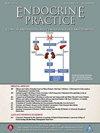One-hour vs Two-hour Postprandial Glucose Targets and Fetomaternal Outcomes in Gestational Diabetes Mellitus: A Systematic Review and Meta-Analysis
IF 3.7
3区 医学
Q2 ENDOCRINOLOGY & METABOLISM
引用次数: 0
Abstract
Objective
The optimal time and target for postprandial glucose (PPG) measurement in gestational diabetes mellitus (GDM) remain unclear. This systematic review and meta-analysis evaluated whether targeting 1-hour PPG (1 hPG) vs 2-hour PPG (2 hPG) altered fetomaternal outcomes in GDM.
Methods
Studies that compared pregnancy outcomes in women undergoing 1 hPG vs 2 hPG monitoring in GDM were identified through comprehensive search of electronic databases. Primary outcomes analyzed were large-for-gestational age (LGA) and macrosomia. Secondary outcomes included low birthweight (LBW), neonatal intensive-care unit admission, neonatal hypoglycemia, cesarean section (CS), pre-eclampsia, gestational age at delivery, and preterm delivery.
Results
Six articles that compared 1 hPG<140 mg/dL (7.8 mmol/L) vs 2 hPG <120 mg/dL (7.2 mmol/L) were analyzed. Additionally, 3 articles that assessed 1 hPG<120 mg/dL vs1 hPG<140 mg/dL were also examined. Targeting 1 hPG<140 mg/dL vs 2 hPG<120 mg/dL significantly lowered the risk of LGA [odds ratio (OR) 0.54; 95% confidence interval (CI): 0.32-0.93; P = .03] but not macrosomia [OR 0.45; 95%CI:0.19-1.06; P = .07]. There was no difference in other parameters such as birthweight [mean difference -61.77g; 95%CI:−152.16-28.62; P = .018], LBW [OR 0.90; 95%CI:0.30-2.68;P = .85], neonatal hypoglycemia [OR 0.60; 95%CI:0.28-1.26; P = .18], gestational age at delivery [mean difference 0.20 weeks; 95%CI:−0.29-0.68; P = .43], CS [OR 0.99; 95%CI:0.46-2.12;P = .97], pre-eclampsia [OR 0.66;95% CI:.22-1.96; P = .46], or need for insulin therapy [OR 1.39; 95%CI:.79-2.43; P = .25]. More intensive 1 hPG target <120 mg/dL vs <140 mg/dl increased the risk of preterm delivery [OR 1.62; 95% CI:1.00-2.62; P = .05], without affecting birthweight, LGA, macrosomia, LBW, and CS.
Conclusion
Our findings suggest that targeting 1 hPG <140 mg/dL vs 2 hPG<120 mg/dL lowers the risk of LGA, but does not affect other parameters. A stricter target of 1 hPG<120 mg/dL can increase the risk of preterm delivery. Further studies to corroborate these findings are necessary.
妊娠期糖尿病1小时vs 2小时餐后血糖指标和母婴结局:一项系统回顾和荟萃分析
目的:妊娠期糖尿病(GDM)餐后血糖(PPG)测定的最佳时间和目标尚不明确。本系统综述和荟萃分析评估了针对1小时PPG (1hPG)和2小时PPG (2hPG)是否会改变GDM的母婴结局。方法:通过全面检索电子数据库,确定比较GDM中1hPG和2hPG监测妇女妊娠结局的研究。分析的主要结局是大胎龄(LGA)和巨大儿。次要结局包括低出生体重(LBW)、新生儿重症监护病房(NICU)入院、新生儿低血糖、剖宫产(CS)、先兆子痫、分娩时胎龄和早产。结果:6篇文章比较了1hPG。结论:我们的研究结果表明,靶向1hPG
本文章由计算机程序翻译,如有差异,请以英文原文为准。
求助全文
约1分钟内获得全文
求助全文
来源期刊

Endocrine Practice
ENDOCRINOLOGY & METABOLISM-
CiteScore
7.60
自引率
2.40%
发文量
546
审稿时长
41 days
期刊介绍:
Endocrine Practice (ISSN: 1530-891X), a peer-reviewed journal published twelve times a year, is the official journal of the American Association of Clinical Endocrinologists (AACE). The primary mission of Endocrine Practice is to enhance the health care of patients with endocrine diseases through continuing education of practicing endocrinologists.
 求助内容:
求助内容: 应助结果提醒方式:
应助结果提醒方式:


